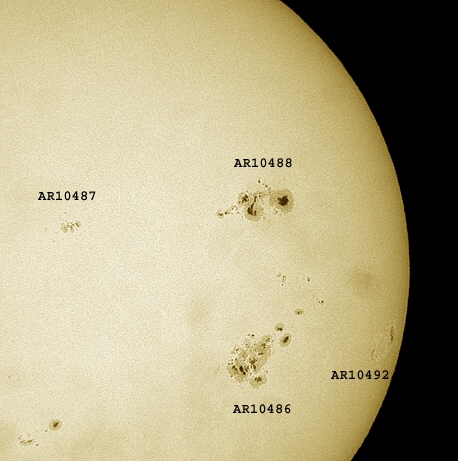
Perhaps the most obvious feature of the sun is the sunspots that characterize the photosphere. The base temperature of
the 300-km deep photosphere is approximately 6400 °C whereas the sunspot regions are characterized with areas of
relatively lower temperature (around 4800 °C for the umbral regions and 5900 °C for the penumbral regions) and increased
magnetic activity (up to 3000 times the average magnetic field of the sun). Due to the differential rate of rotation of
the solar disk (26 days at the equator and 36 days at the poles), there is a "twisting" of the magnetic fields which
surface to the photosphere producing sunspots. Typically, these spots and groups are found to lie + 30° of the
solar equator and can physically be many-fold times larger than our planet! As the images below indicate, sunspots are
characterized with a dark core, the "umbra", where the temperature is about 1600 °C less than the surrounding temperature
of the photosphere whereas the less darker envelope which typically encompasses the umbral region, the "penumbra", is
about only 500 °C less than the surrounding photospheric temperature.
Studies have shown sunsplot activity to exhibit an eleven-yr cycle with virtually little sunspot activity during the
minima of the cycle whereas frequent sunspots and associated groups dominate during the maximum of the same cycle,
typically approximately 4.5 years after the minimum. During the solar maximum, we also have frequent filaments, flares and
prominences (see here) which include ejected material from the
sun's outermost "shell", the chromosphere, that reaches earth causing, for example, geomagnetic storms that produce the
well-known and beautiful aurora borealis and australis.
Note: The sunspot groups AR10486 (Zurich class: Fkc, 18° S, 18° W) and AR10488 (Zurich class:
Fkc, 08° N, 28° W) are each approximately the size of Jupiter and are the source of X-class coronal mass ejections with
AR10486 being directly responsible for auroral activity. Of lesser importance are sunspots AR10487 (Zurich class: Dko,
12° N, 06° E) and AR10492 (Zurich class: Eko, 23° S, 62° W) in the vicinity of AR10486 which represent the only other
major sources of activity. Further details for these active regions are available
here.
Similarly, for a full-disk image of today's sun by the author, please click
here.
Note: There are some small "smudges" in the image below. This is due to some very thin clouds.
|
Body: Sun Mass: 332,900 x Earth Mean Eq Diameter: 109.1 x Earth Distance: 152 million km RA / Dec: 14h 20m 54s / -14° 02' 32" Diameter: 32.17' Magnitude: -26.8 Light Time: 0h 8m 21.6s |

|
Date: Oct 31, 2003 13:28:07 UT+2 Location: Athens, Greece Equipment: TeleVue Pronto TeleVue 3x Barlow Celestron CG-3 GEM ScopeTronix STWA14 Adapter Nikon Coolpix 995 Baader ND-5 (full-aperture) Exposures: 1 x 1/300 sec @ f4.2 ISO Auto JPG RGB Fine image format 2048x1536 image size Autodark subtraction Software: Photoshop V6 Processing: Unsharp Masking Grayscale Brightness/Contrast Levels Resampling (30%) Cropping JPG Compression |